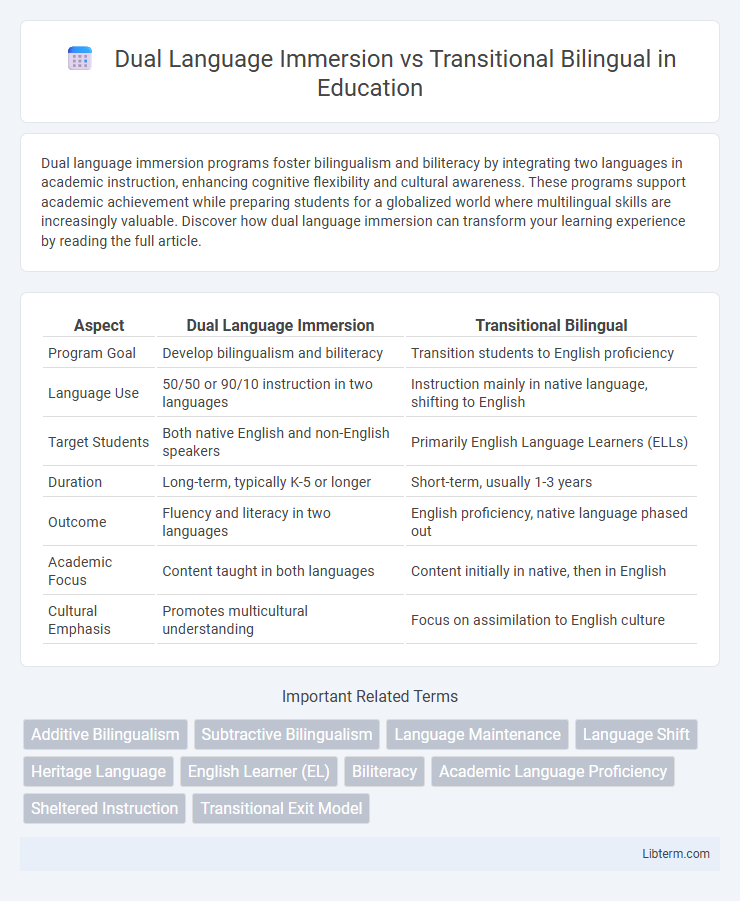Dual language immersion programs foster bilingualism and biliteracy by integrating two languages in academic instruction, enhancing cognitive flexibility and cultural awareness. These programs support academic achievement while preparing students for a globalized world where multilingual skills are increasingly valuable. Discover how dual language immersion can transform your learning experience by reading the full article.
Table of Comparison
| Aspect | Dual Language Immersion | Transitional Bilingual |
|---|---|---|
| Program Goal | Develop bilingualism and biliteracy | Transition students to English proficiency |
| Language Use | 50/50 or 90/10 instruction in two languages | Instruction mainly in native language, shifting to English |
| Target Students | Both native English and non-English speakers | Primarily English Language Learners (ELLs) |
| Duration | Long-term, typically K-5 or longer | Short-term, usually 1-3 years |
| Outcome | Fluency and literacy in two languages | English proficiency, native language phased out |
| Academic Focus | Content taught in both languages | Content initially in native, then in English |
| Cultural Emphasis | Promotes multicultural understanding | Focus on assimilation to English culture |
Understanding Dual Language Immersion
Dual Language Immersion programs promote bilingualism and biliteracy by educating students in two languages across grade levels, balancing native English speakers and English Language Learners to foster both languages equally. This approach supports cognitive flexibility, cultural awareness, and academic achievement in both languages, unlike Transitional Bilingual programs that primarily focus on shifting students to English proficiency. Research demonstrates that Dual Language Immersion students outperform peers in standardized tests and maintain long-term language skills, highlighting the program's effectiveness in promoting sustained bilingual competence.
What is Transitional Bilingual Education?
Transitional Bilingual Education (TBE) is an instructional model designed to help English Language Learners (ELLs) acquire English proficiency while gradually transitioning from their native language to English-only instruction. TBE programs provide initial content instruction in the student's home language, supporting comprehension and academic development before shifting predominantly to English. The primary goal of TBE is to promote English fluency within a limited time frame, often resulting in full English immersion by the end of the transition period.
Key Goals of Both Educational Models
Dual Language Immersion programs aim to develop bilingualism, biliteracy, and cross-cultural competence by integrating native English speakers and English language learners in the same classroom to promote equal proficiency in both languages. Transitional Bilingual Education primarily focuses on rapidly transitioning English language learners to English-only instruction while maintaining native language support temporarily to ensure comprehension and core academic achievement. Both models emphasize language proficiency and academic success but differ in duration and the goal of maintaining versus phasing out the native language.
Language Proficiency Outcomes
Dual Language Immersion programs promote higher levels of bilingual proficiency by providing sustained instruction in both the native and target languages, leading to greater fluency and literacy in each. Transitional Bilingual programs primarily focus on English acquisition, often resulting in limited proficiency in the native language after program completion. Studies indicate that students in Dual Language Immersion achieve stronger cognitive flexibility and long-term academic success compared to those in Transitional Bilingual models.
Academic Achievement Comparisons
Dual Language Immersion programs consistently demonstrate higher academic achievement, with students often outperforming their peers in Transitional Bilingual Education (TBE) on standardized tests in reading, math, and language proficiency. Research indicates that DLI students gain bilingualism and biliteracy while maintaining grade-level or above-grade-level performance in core subjects. Conversely, TBE programs primarily support initial language transition and may show slower long-term academic growth compared to dual language models.
Cultural Identity and Integration
Dual Language Immersion programs promote strong cultural identity and integration by fostering bilingualism and biliteracy, enabling students to maintain their heritage language while mastering English. Transitional Bilingual programs primarily focus on English acquisition, often leading to a diminished connection with the student's native culture and reduced opportunities for cultural integration. Research shows that Dual Language Immersion supports positive self-identity and cross-cultural understanding, enhancing social cohesion within diverse communities.
Challenges and Limitations
Dual Language Immersion programs often face challenges such as staffing shortages of bilingual teachers and difficulties in maintaining balanced proficiency in both languages for all students. Transitional Bilingual programs encounter limitations including inadequate support for heritage language development and the risk of students losing their native language as they transition to English dominance. Both approaches require ongoing resources and parental involvement to effectively address linguistic, cultural, and academic needs.
Parental and Community Involvement
Dual Language Immersion programs foster strong parental and community involvement by encouraging active participation in both languages, enhancing cultural exchange and support networks. Transitional Bilingual programs often see more limited engagement, as they focus primarily on English proficiency and may not equally promote home language use or multicultural community events. Studies show that schools with Dual Language Immersion models report higher parental attendance at school events and greater volunteer participation, strengthening overall community ties.
Teacher Qualifications and Training
Dual Language Immersion programs require teachers to possess bilingual proficiency and specialized training in dual-language pedagogy to support simultaneous language development. In contrast, Transitional Bilingual Education teachers often need certification in ESL or bilingual education with a focus on language acquisition aimed at transitioning students to English proficiency. Professional development for Dual Language Immersion educators emphasizes cultural competency and sustained biliteracy strategies, whereas Transitional Bilingual teachers receive training centered on English language support and gradual language shift methodologies.
Future Trends in Bilingual Education
Future trends in bilingual education highlight a growing preference for Dual Language Immersion programs due to their proven effectiveness in achieving bilingualism and biliteracy, fostering cognitive flexibility, and promoting cultural competence. Research indicates that Dual Language Immersion participants outperform their peers in academic achievement and long-term language retention compared to Transitional Bilingual programs, which primarily focus on English proficiency before phasing out the native language. Educational policymakers are increasingly advocating for Dual Language Immersion models to meet the demands of global communication and multicultural workforce preparation.
Dual Language Immersion Infographic

 libterm.com
libterm.com